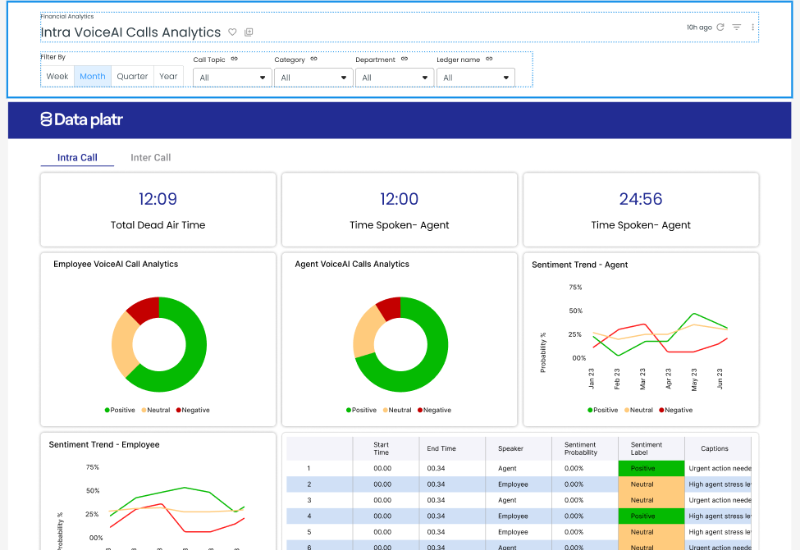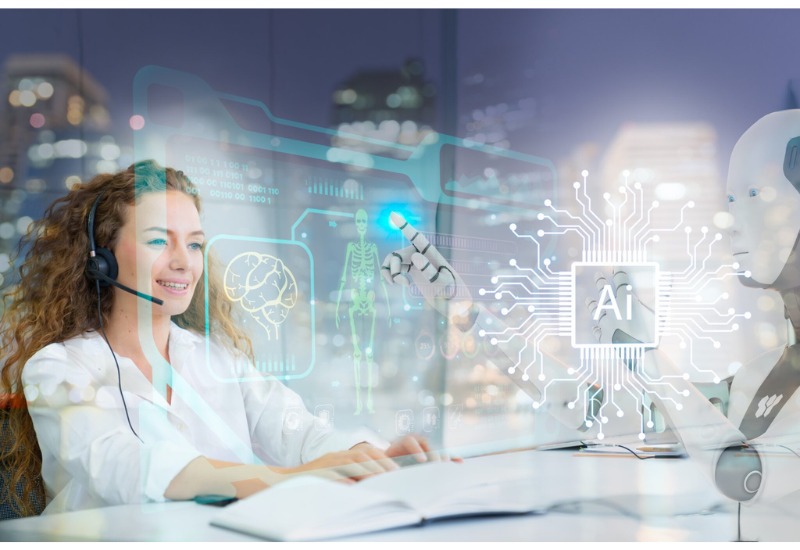Artificial Intelligence (AI) has come a long way from processing single types of data. Multimodal AI represents a most important step in the evolution of artificial intelligence systems. More than traditional models that rely on a single type of input, multimodal Artificial Intelligence is designed to process and understand information from multiple data sources such as text, images, audio, and video. This approach brings machines closer to how humans perceive and interpret the world using various senses together.
In this blog, we’ll explore what multimodal AI is, how it works, its real world applications, the top models driving its development, and how it compares to other forms of AI like unimodal and generative AI.
What is Multimodal AI?
Multimodal AI refers to artificial intelligence systems that can process, integrate, and interpret data from multiple ways. A "modality" refers to a specific type of data such as text, speech, images, or sensor signals. By combining inputs from various sources, It can form a richer and more accurate understanding of the context compared to unimodal systems, which rely on only one data type.
For example, consider how humans communicate: we use language (text/speech), gestures, facial expressions, and context clues.
After the inputs are combined, the system builds a shared understanding of all the information. This helps the AI make smarter choices, like recognizing an object in a photo by also reading its caption or hearing related sounds. It can then carry out tasks such as describing an image, answering questions, or translating languages. By using more than one type of input, multimodal Artificial Intelligence becomes better at understanding the full picture and giving more accurate and useful results.
What is an example of multimodal AI in real life?
Modern virtual meeting tools like Zoom with AI features or Microsoft Teams with Copilot use multimodal AI to enhance user experience. These platforms analyze spoken language (audio), shared screen content (visual), and chat messages (text) simultaneously. The AI can generate meeting summaries, detect sentiment, auto caption in real time, and even identify action items. This makes virtual collaboration more intelligent and efficient.
Other examples include:
- Smart assistants - Tools like Google Assistant interpret voice input and screen context to offer helpful actions, a classic example of multimodal processing.
- Healthcare diagnostics - By combining imaging (like X-rays), lab results, and patient history, custom multimodal Artificial Intelligence aids in more accurate diagnosis and treatment.
- Retail - AI in retail merges customer behavior, voice searches, and visual queries to enhance shopping experiences and personalized recommendations.
How Does Multimodal AI Work?
Multimodal Artificial Intelligence operates through a combination of data fusion, deep learning, and neural networks. The system first processes each modality using dedicated encoders (like CNNs for images or transformers for text). Then, it aligns and integrates the data in a shared representation space using fusion strategies like:
- Early Fusion: data from various modalities (e.g., image, text, audio) is combined before being processed by the model. This method allows the AI to learn joint features from raw multimodal input early in the pipeline.
- Late Fusion: Late fusion processes each modality separately and merges the outcomes at the decision stage. It’s useful when modalities are independent or require different processing pipelines.
- Hybrid Fusion: Hybrid fusion combines raw data from multiple sources before processing. It offers flexibility to handle complex multimodal tasks.
This integrated approach enables the AI to recognize relationships between different data types, such as linking a spoken command to a relevant image or generating a text summary of a video.
Popular Multimodal AI Models
Several advanced models are driving the adoption and success of multimodal Artificial Intelligence. Some of the most famous include:
- OpenAI's GPT-4: GPT-4 is a powerful multimodal tool that can process both text and image inputs. It understands complex queries that involve visual context, such as interpreting charts, images, or mixed format documents. This enhances user interactions, enabling tasks like visual reasoning and content summarization. Its versatility makes it highly useful in education, research, and enterprise applications.
- CLIP (Contrastive Language Image Pre-training): CLIP developed by OpenAI, visual concepts from natural language supervision by associating images and text in a shared space. It can identify images based on written prompts without needing labeled datasets. This allows for flexible image classification, visual search, and zero-shot learning across many domains. CLIP bridges the gap between visual perception and linguistic understanding.
- DALL·E: DALL·E is a generative model that creates detailed and creative images from natural language descriptions. It combines vision and language understanding to turn textual prompts into artwork or photo realistic imagery. This model showcases the creative potential of multimodal Artificial Intelligence in design, content marketing, and entertainment.
- Flamingo by DeepMind: Flamingo is a learning model designed to handle visual and textual inputs across a wide range of tasks. It can interpret images, generate captions, and answer questions by integrating information from different modalities. The model stands out for its strong performance with minimal task specific tuning. It's particularly effective in interactive AI settings and multimedia environments.
- VisualBERT and ViLT: VisualBERT and ViLT are hybrid models that fuse natural language processing with visual input. These models understand and reason about image text, allowing use cases like visual question answering, image captioning, and sentiment analysis. VisualBERT uses both image region features and text tokens, while ViLT focuses on lightweight, transformer based processing without relying on CNNs.
These models are capable of tasks ranging from content generation and translation to sentiment analysis and visual question answering.
Multimodal AI challenges
Despite its promise, multimodal Artificial Intelligence comes with significant challenges:
- Data Alignment: Synchronizing different modalities (like matching video frames with speech) is technically complex and vital for model accuracy.
- Data Scarcity: There’s a shortage of high quality datasets that contain multiple aligned modalities, limiting model performance and development.
- Bias and Fairness: Disparities in how data types are collected or represented can introduce bias, leading to unfair or inaccurate outcomes in multimodal Artificial Intelligence.
- Computational Cost: Multimodal requires significant resources for training and inference, as it processes and fuses multiple complex data streams.
- Interpretability: Understanding how the model arrives at a decision is harder when multiple data sources interact, raising concerns for AI transparency.
Addressing these issues is crucial for building responsible and trustworthy multimodal Artificial Intelligence systems.
Multimodal AI vs Unimodal AI
The key difference in the diversity of inputs:
- Multimodal AI can handle a variety of data simultaneously, leading to better contextual understanding and more accurate results.
- Unimodal AI on the other hand, can process only one type of data (e.g., text-only or image-only). These systems are often limited in understanding complex scenarios where multiple data types are involved.
Think of it like this: while unimodal AI is like reading a book with only words, multimodal Artificial Intelligence is like watching a movie, you get visuals, sound, and subtitles all at once.
Multimodal AI vs Generative AI
Generative AI is designed to create new content like writing text, generating images, or composing music based on learned data patterns. Multimodal AI, meanwhile, focuses on understanding and integrating multiple data formats to analyze or respond more intelligently. While different in purpose, the two often overlap in models like GPT-4, which can both process varied inputs and generate outputs.
So, generative AI is about creation, while multimodal Artificial Intelligence is about comprehension across formats. Some models like DALL·E or Gemini combine both capabilities.
Multimodal AI Applications
Multimodal Artificial Intelligence is transforming industries by enabling more intelligent, responsive, and context-aware systems. Some key application areas include:
- Healthcare: Multimodal is used to support medical diagnosis by analyzing X-rays, MRI scans, and patient records together. This helps doctors make faster and more accurate decisions based on both visual and written data.
- Marketing & Retail: Multimodal Artificial Intelligence powers smart shopping assistants that understand voice commands, scan product images, and respond to text queries. This improves customer experience through personalized and seamless interactions.
- Education: Educational platforms use multimodal to combine video lectures, interactive quizzes, and voice-based support. This creates more engaging and accessible learning experiences for students of all ages.
- Media & Entertainment: Multimodal is used to generate creative content like AI-generated images, music, and video effects. It also enhances video editing, auto captioning, and content recommendation based on user behavior.
- Content Creation: Tools like DALL·E or Runway allow creators to generate rich media content from simple text prompts.
- Security & Surveillance: Advanced surveillance systems use multimodal Artificial Intelligence to process video footage, detect unusual sounds, and track movements. This combination improves threat detection and real time response in public and private spaces.
Conclusion
Multimodal AI is not just the next step in AI evolution, it's a leap toward more natural, human-like intelligence. As AI systems continue to merge visual, textual, and auditory data, the applications are set to transform industries, reshape user experiences, and redefine how we interact with machines.
At its core, multimodal Artificial Intelligence brings us closer to a world where technology can truly see, hear, and understand like we do.
Contact us at [email protected] or Book time with me to organize a 100%-free, no-obligation call
Follow us on LinkedIn for more interesting updates.

















